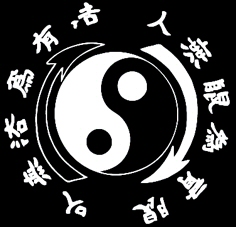Academy of Jeet Kune Do Fighting Technology
Athens
Greece
Jun Fan Jeet Kune Do Instructor
Vagelis Zorbas

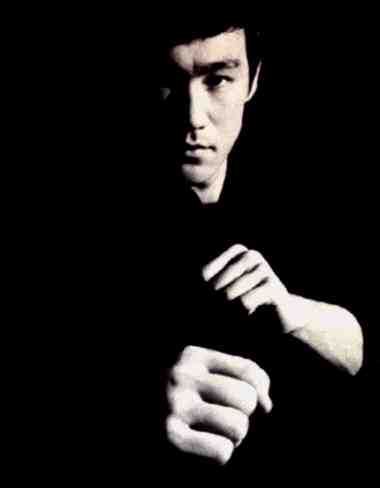
More
than a Flesh Wound
When
man bites man, the hands are the most frequent targets. Although the nips
themselves are rarely fatal, 10 percent to 15 percent of the injuries
become infected when left untreated. Before the development of
antibiotics, approximately 20 percent of all hand bites resulted in the
amputation of a finger.
Kina Mutai (Kino Mutai)
Biting and Eye Gouging
Why
You Need to Know the Philippine Art of Kino Mutai.
If
you look back at the history of the Philippines, you will see war and
bloodshed. During many of their battles, the Filipinos found themselves
outnumbered, outgunned or both. Consequently, they developed an ideology
that focused on finding a way to put themselves on equal footing with
their adversaries, to somehow circumvent the odds. They were forced to be
innovative in dealing with the harsh reality of the times.
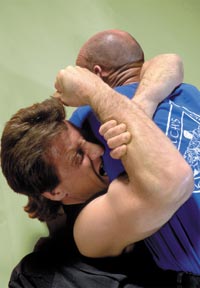
For the Filipinos, "circumvent" ended up meaning "find a
way to cheat." In the world of weapons combat, they concocted an
amazing way of cheating: Instead of blocking a strike with their own
weapon, they would smash or cut the opponent’s weapon hand. The opponent
was likened to a snake and the weapon was the fangs of the snake; hence,
the method was called "defanging the snake." While the rest of
the world went toe-to-toe while fighting with weapons—blocking strikes
and trading blows like nobody’s business—the Filipinos would simply
attack the hand. When fighting with empty hands, the Filipinos employed
the same ideology. Instead of blocking punches and kicks, they used nerve
destructions against the incoming limbs. Rather than exchange blows with
their opponents, they got inside and implemented strategic knee thrusts,
elbow strikes and head butts. Once again, they were trying to circumvent
the reality of their situation and put themselves on an equal footing with
their enemies.
The
Equalizer
Now that the central theme of the Filipino paradigm—of David being
forced to overcome Goliath—has been described, we will delve into the
world of grappling and the topic of this article, kino mutai, or
the "art of biting and pinching." Jeet kune do
practitioners refer to it as "biting and eye gouging" because
their preferred area to pinch is the opponent’s eyeball.
 Many
Philippine escrimadors (escrima practitioners) possessed an
invaluable attribute that most people today simply do not have: incredible
grip strength. That was a byproduct of wielding heavy sticks, swords and
knives all day long. One of the most famous grandmasters, Floro
Villabrille, could actually husk coconuts with his bare hands. By no
coincidence, Bruce Lee also possessed incredible grip strength, and he
used innovative equipment to further develop tendon strength in his
fingers and forearms. A strong grip is one of the most important
attributes in kino mutai because being able to hold onto an opponent while
biting him is the Philippine way of cheating on the ground.
Many
Philippine escrimadors (escrima practitioners) possessed an
invaluable attribute that most people today simply do not have: incredible
grip strength. That was a byproduct of wielding heavy sticks, swords and
knives all day long. One of the most famous grandmasters, Floro
Villabrille, could actually husk coconuts with his bare hands. By no
coincidence, Bruce Lee also possessed incredible grip strength, and he
used innovative equipment to further develop tendon strength in his
fingers and forearms. A strong grip is one of the most important
attributes in kino mutai because being able to hold onto an opponent while
biting him is the Philippine way of cheating on the ground.
The Art
Whenever biting is mentioned, the first thing that usually comes to mind
is, "Anyone can bite." In reality, that bland assertion is true,
but the difference between "just plain biting" and kino mutai is
how to bite, where to bite and when to bite. A kino
mutai practitioner’s bite is "uninterrupted." That means he
knows the exact places on your body to bite and does so with precise
timing. He grabs hold of you using his superior grip strength and bites
areas that would take you literally minutes to pull him off. There are
more than 140 places on the human body that he can bite for as long as he
wants. While biting, he is implementing his knowledge of kinesiology and
sensitivity to hang on like a pit bull.
In the world of wrestling, Brazilian-jujutsu practitioners are
clearly the kings. Their subtle body movements, ground sensitivity and
knowledge of leverage, escapes and finishing moves put them in a league of
their own. When jujutsu is combined with kino mutai, the result is perhaps
the most formidable hybrid grappling art on the planet. In a street fight,
you can use the mix against a bigger, stronger ground fighter—if not to
beat him on the ground, then to create enough space to get back on your
feet (even if your only goal is to run).
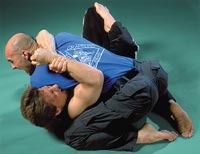 The
Training
The
Training
Before you begin practicing kino
mutai, you must learn the essential principles. First is how to bite.
You should always be cognizant of how much flesh is in your mouth.
Typically, the average person will try to use all his teeth and take too
much "meat" in one bite. To avoid that pitfall, you must angle
your face so the pressure is applied directly on the incisors. The actual
motion of the bite is a repeated circular ripping of the flesh, resulting
in numerous smaller bites which, when applied cumulatively, inflict
considerable damage.
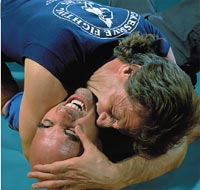 The
best way to practice this is to get a large piece of beef and place it
inside a T-shirt. Next, set a timer and explode into it with the goal of
tearing through the entire piece of beef as quickly as possible. At the
beginning of the drill, you will encounter several hurdles. First, you
will notice your teeth hydroplaning across the surface of the meat without
actually penetrating. Varying the angle and pressure of the bite (using
the attribute of sensitivity) can mitigate this problem. Second, halfway
through the practice session you may discover one side of your jaw muscle
cramping. When that happens, you can turn your head to engage the incisors
on the opposite side.
The
best way to practice this is to get a large piece of beef and place it
inside a T-shirt. Next, set a timer and explode into it with the goal of
tearing through the entire piece of beef as quickly as possible. At the
beginning of the drill, you will encounter several hurdles. First, you
will notice your teeth hydroplaning across the surface of the meat without
actually penetrating. Varying the angle and pressure of the bite (using
the attribute of sensitivity) can mitigate this problem. Second, halfway
through the practice session you may discover one side of your jaw muscle
cramping. When that happens, you can turn your head to engage the incisors
on the opposite side.
The more you practice this drill, the better your body mechanics will
become, the easier it will be to make small, circular bites and the faster
you will be able to gnaw through the beef. At the beginning, it may take
two or three minutes to get through the meat. After 20 or 30 pot roasts,
however, you will find that you can tear your way through a 5-pound slab
of meat inside of 10 seconds.
The next point that must be addressed is the most important concept of
kino mutai: the ability to bite someone uninterrupted. To understand
uninterrupted biting, picture yourself holding your opponent in a bear hug
with your arms wrapped around his torso (or imagine he is held in your
guard and your arms are wrapped around his neck) while you are biting his
throat. If you do not have a firm grip on him while you bite, his
instinctive response will be to pull away, resulting in a small puncture
wound that will hardly do any damage. Applying the proper "vice
grip" while making small tears with your incisors, however, will give
you the ability to hang on and bite him until next Christmas.
The
Targets
That brings up the next item: where to bite. Yes, you can use your teeth
just about anywhere on your opponent’s body, but to bite uninterrupted
you must target specific areas. What constitutes a good area to bite?
First, it should be extremely sensitive to pain. The cheek, neck, ear,
nipple, latissimus dorsi muscle and groin are sensitive regions with many
nerve endings. Second, it should be an area that will allow you to
position yourself so your opponent cannot counter your bite by pulling
away or pushing you away. The importance of biting a sensitive area while
hanging on cannot be overstated. Using some basic jujutsu positions, we
will present a few of the many possible bites.
• If you are mounted on your opponent, you can bite his face and neck.
• If you are in the cross-side position, you can bite his cheek, ear or
neck.
• If you are in the north-south position, you can bite his groin.
• If you have him in your guard, you can bite his cheek, ear or neck.
• If you are in his guard, you can bite his nipple.
• If you are on the bottom of the cross-side position, you can bite the
latissimus muscle if his elbow is across your body or his neck if his
elbow is elsewhere.
Remember: The key is to hold your opponent so you can bite as long as you
want. He will try to get the source of the pain—your teeth—away from
his body as quickly as possible. That means he will try to create space
between his body and yours. You can then take advantage of that space and
push or kick him off. If you are pinned under someone much stronger and
heavier than you, biting is the fastest way to escape. If, however, you
fail to hang onto him while you bite, he will be able to pull away before
your bite can inflict the damage required to get the reaction you need.
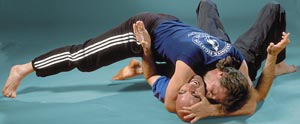 The
Drill
The
Drill
Once you understand the concepts discussed above, it’s time to try kino
mutai in sparring. The following drill will help you learn when to bite:
While you and your partner grapple, look for the appropriate areas of his
body to bite. Called target acquisition, this process can take from one to
five minutes. Timing is critical, and only by actually rolling on the mat
will you be able to develop the ability to engage in kino mutai at will.
Once you have selected the target, your next step is to hold your training
partner as firmly as you can to ensure that your bite will be
uninterrupted. Then you simulate the bite by pressing your face firmly
against the target for as long as possible. The moment your partner feels
the "bite" being applied, he should attempt to defend himself by
pushing your face away, breaking the hold, etc. If you apply the technique
correctly, it should take him at least 10 seconds to escape the simulated
bite.
The
Eyes
The second half of the kino mutai equation is the uninterrupted eye gouge.
To train for it, you can use the same methodology as for biting: First
wrestle slowly while you acquire a target. Each position that is
advantageous for biting can also work for eye gouging—with the exception
of the north-south position. Grab your opponent’s neck and gently
press on his eyeball until he pulls your hand away.
As you get better, he can wear swim goggles so you can practice the eye
gouge more aggressively.
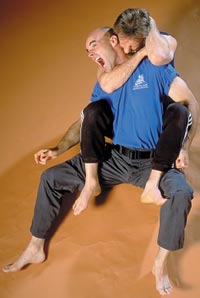 The
Alternative
The
Alternative
One often-overlooked advantage of using kino mutai is the tremendous
psychological damage that a vicious bite or eye gouge will inflict. When
you bite uninterrupted and your assailant cannot stop the pain, you cause
him to panic. Because you are also biting a sensitive area, in essence you
are destroying him emotionally.
Kino mutai should be used only as a last resort. These days, the thought
of having the blood of an unknown person in your mouth is certainly
objectionable. However, in a life-or-death situation, biting at precisely
the right time could enable you to create enough space to escape.
In the martial arts, there must be a clear distinction between
self-preservation (doing whatever it takes to save yourself and your loved
ones) and self-perfection (the sport and training aspects of a style).
When you think about bludgeoning someone with a stick, stabbing him with a
knife or biting a hole in his face, it is obviously distasteful. However,
when it comes to protecting the life of your mother, your spouse or your
children, is there anything you wouldn’t do?
